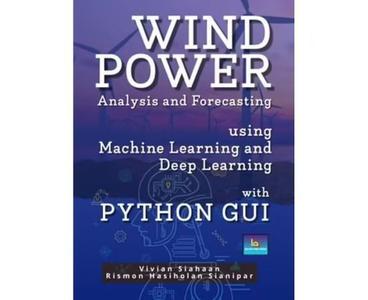Wind Power Analysis And Forecasting Using Machine Learning With Python

Free Download Wind Power Analysis And Forecasting Using Machine Learning With Python by Vivian Siahaan
English | May 18, 2022 | ISBN: B0B1Q4LP6Q | 215 pages | MOBI | 18 Mb
In this project on wind power analysis and forecasting using machine learning with Python, we started by exploring the dataset. We examined the available features and the target variable, which is the active power generated by wind turbines. The dataset likely contained information about various meteorological parameters and the corresponding active power measurements.
To begin our analysis, we focused on the regression task of predicting the active power using regression algorithms. We split the dataset into training and testing sets and preprocessed the data by handling missing values and performing feature scaling. The preprocessing step ensured that the data was suitable for training machine learning models.
Next, we trained several regression models on the preprocessed data. We utilized algorithms such as Linear Regression, Decision Tree Regression, Random Forest Regression, and Gradient Boosting Regression. Each model was trained on the training set and evaluated on the testing set using performance metrics like mean squared error (MSE) and R-squared score. After obtaining regression models for active power prediction, we shifted our focus to predicting categorized active power using machine learning models. This involved converting the continuous active power values into discrete categories or classes. We defined categories based on certain thresholds or ranges of active power values.
For the categorized active power prediction task, we employed classification algorithms. Similar to the regression task, we split the dataset, preprocessed the data, and trained various classification models. Common classification algorithms used were Logistic Regression, Support Vector Machines (SVM), K-Nearest Neighbors (KNN), Decision Trees, Random Forests, Gradient Boosting, Extreme Gradient Boosting, Multi-Layer Perceptron, and Light Gradient Boosting models.
During the training and evaluation of classification models, we used performance metrics like accuracy, precision, recall, and F1-score to assess the models’ predictive capabilities. Additionally, we analyzed the classification reports to gain insights into the models’ performance for each category. Throughout the process, we paid attention to feature scaling techniques such as normalization and standardization. These techniques were applied to ensure that the features were on a similar scale and to prevent any bias or dominance of certain features during model training.
The results of predicting categorized active power using machine learning models were highly encouraging. The models demonstrated exceptional accuracy and exhibited strong classification performance across all categories. The findings from this analysis have significant implications for wind power forecasting and monitoring systems, allowing for more effective categorization and management of wind power generation based on predicted active power levels.
To summarize, the wind power analysis and forecasting session involved dataset exploration, active power regression using regression algorithms, and predicting categorized active power using various machine learning models. The regression task aimed to predict continuous active power values, while the classification task aimed to predict discrete categories of active power. Preprocessing, training, evaluation, and performance analysis were key steps throughout the session. The selected models, algorithms, and performance metrics varied depending on the specific task at hand. Overall, the project provided a comprehensive overview of applying machine learning techniques to analyze and forecast wind power generation.
DONWLOAD FROM RAPIDGATOR
hq76z.rar.html
DOWNLOAD FROM NITROFLARE
hq76z.rar
DONWLOAD FROM UPLOADGIG
hq76z.rar
Fikper
hq76z.rar.html
